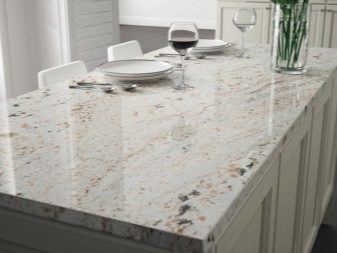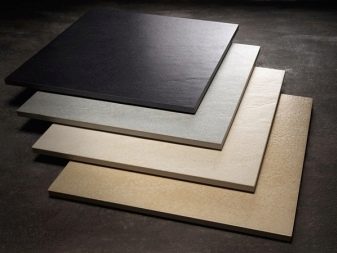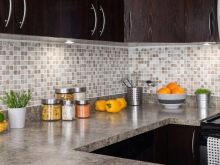Porcelain stoneware table top: do-it-yourself reliable coating

Porcelain stoneware is one of the most popular materials in construction and renovation. Excellent technical properties, a varied color palette ensure the material is widely used in various fields. Today it is especially popular in the manufacture of kitchen countertops.
Porcelain stoneware is a more budget option, rather than granite, at the same time has a high level of strength and reliability, in no way inferior to natural stone.

Advantages
The porcelain stoneware worktop will be appropriate in any kitchen. This is a practical and durable element of the work area that every housewife will like. A wide palette of colors, a variety of coating textures allows you to choose the ideal option for arranging your kitchen.

Porcelain stoneware has a number of advantages:
- Strength. Solid, but not heavy material allows you to install countertops of any, even very large sizes. Due to the relatively low weight, the tabletop will not "press" on the supporting surfaces, which will avoid deformation of the structure.
- Wear resistance. The table top made of porcelain stoneware is not "afraid" of chips and cracks, you can safely cut on it without using a cutting board. The material does not absorb moisture, it is not damaged by grease, oil, paint. Any liquid that gets on the surface can be easily removed.


- Heat resistance. Porcelain stoneware tolerates high temperatures well, so worktops made of this material can be installed near the stove. In addition, they are resistant to thermal and chemical influences. This means that steam, moisture, hot objects will not do any harm to the worktop.
- Structural hard surface. The table top does not crack even after years of use.
- Security. Porcelain stoneware is an absolutely harmless material, it does not emit toxins and other hazardous substances. Such a tabletop is protected from the growth of bacteria and microorganisms.

It is worth noting that porcelain stoneware, like any other material, is not without its drawbacks. The main one is rather complicated processing.
Self-production
Of course, the lining of the kitchen work surface can be entrusted to a specialist, however, having the skills to work with tools, you can easily do it yourself.
The secret of successfully creating a work area from porcelain stoneware with a countertop is high-quality preparation of the base. The rigidity and strength of the structure plays an important role.
This will help to avoid distortion and movement of the base during operation.

Preparation of the base
For the manufacture of a strong base, you can use wood, metal, high-strength plastic, concrete.
The easiest way is to work with a concrete base, in which case the porcelain stoneware is simply laid on its surface. The disadvantage of such a table top is the large weight of the base.
The metal base must be treated with special solutions, after which a steel mesh is stretched, on which tile adhesive is applied. After processing, the surface must be properly dried, and only after that you can start laying the tiles.


Plastic kitchen countertops use MDF or chipboard as a base. Such structures are quite durable and capable of withstanding the weight of porcelain stoneware sheets.
In this case, preparation can be carried out in two ways:
- by attaching the mesh;
- by gluing the tiles with silicone.


Wood surfaces are less durable than metal or plastic. They can "play" under the influence of high temperatures and moisture, so preparation of the substrate requires careful fixation. Strength can be achieved by fixing thick birch plywood in two layers.
All wooden elements need to be treated with special impregnations that will protect them from decay, fungus, mold.

Laying and grouting
Porcelain stoneware is laid on the finished base using “liquid nails” or tile glue.
There are several styling methods:
- rhombus;
- herringbone;
- rows;
- ornament.

The choice of installation method depends on the style and design of the room. To achieve maximum solidity, the width of the joints should be minimal.
The next stage is grouting. It is best to use a moisture resistant epoxy grout. Conventional cement mix needs additional protection. Next, the countertop should be treated with a special impregnation.


Facing with porcelain stoneware, with all its advantages and disadvantages, is a rather profitable option. Compared to the cost of installing a PVC cover, it clearly benefits.
This material provides a wide palette of colors, due to which there is an optimal version of a sheet of porcelain stoneware for each interior. For example, imitation of natural stone (marble, granite) will be appropriate in any kitchen interior.


The working area, made of porcelain stoneware, is in many ways superior to that of natural stone. Its production will cost several times cheaper. Artificial stone is inferior to porcelain stoneware in strength qualities. Therefore, choosing a material for decorating a kitchen space, porcelain stoneware will be the best option in terms of price-quality ratio.

Features of large format material
A standard sheet of thin large-format porcelain stoneware is 1000x3000 mm. If you want to make a tabletop, the size of which exceeds the parameters of these parameters, then the laying of two sheets occurs joint to joint. To do this almost imperceptibly, the joint must be carefully putty.
The edge of the countertop must be finished with the same porcelain stoneware as the countertop itself. Joints are machined with chamfering or radii.
The standard edge width (or tabletop thickness) is 20 mm. Making a countertop with your own hands, you can make whatever thickness you want.

Professional advice
When making a countertop yourself, there are many nuances, knowing which you can avoid standard mistakes:
- Over time, the grout can lose its whiteness and take on a dirty gray tint. This can be corrected only by refreshening the seams with a new grout.
- Porcelain stoneware has high strength properties. A diamond disc is used to cut the sheets. High-quality cutting of material comes with experience, so when starting to create a tabletop with your own hands, be prepared for difficulties at this stage.
- Any kind of porcelain stoneware is suitable for creating a working area in the kitchen. It is recommended to purchase smoother sheets, as dirt and food particles will accumulate on an uneven surface.


Care
The table top made of this material does not need careful maintenance. Wiping the countertop 1-2 times a day with warm water or treating it with a special agent, you will provide it with beauty and shine for years to come.
Despite the fact that porcelain stoneware is a durable material, do not abuse acid-based abrasives for cleaning it.
It is best to use special polishes and cleaners, which will help get rid of the coating of grease and dirt in a matter of minutes.
It is important to handle the surface with care, because repairing damage or chips will require serious costs.

Reviews
Almost all owners of porcelain stoneware countertops agree that today it is difficult to find a material that is more practical and more profitable.
Modern technologies make it possible to create an excellent analogue of the natural stone itself, which is not only able to withstand heavy loads, but also differs in a more affordable cost.
Porcelain stoneware is also loved for the variety of textures and colors. A long service life will ensure the functionality of the kitchen area for many years.
Modern countertops made of porcelain stoneware are made mainly monolithic, creating the effect of a single space. However, countertops "under a tree" or with a marble pattern look no less interesting in the interior.




Place in the interior
You can style the entire room and select a work area in it using only one tabletop.
It should be noted that a massive work area will be appropriate in a large room with high ceilings. But for arranging a small square kitchen, it is better to use a small countertop.
When choosing a material for creating a countertop, do not forget that this part of the interior is usually bought once every few years. Replacing a countertop is a laborious and costly process, so it is better to take a serious approach to the choice of material for it right away.



Finishing with wood-effect porcelain stoneware sheets will add warmth and comfort to the atmosphere. The clinker tile will look good in a room made in a strict minimalist style. Covering with polished or glossy tiles looks elegant and beautiful in any interior.

Dining tables with a porcelain stoneware surface look especially original. Moreover, modern manufacturers offer a wide range of such tables: compact and massive, with a square, rectangular or oval shape.
Porcelain stoneware is a unique material, experimenting with which you can create a unique kitchen design.


For information on how to properly lay a porcelain stoneware countertop, see the next video.













The comment was sent successfully.